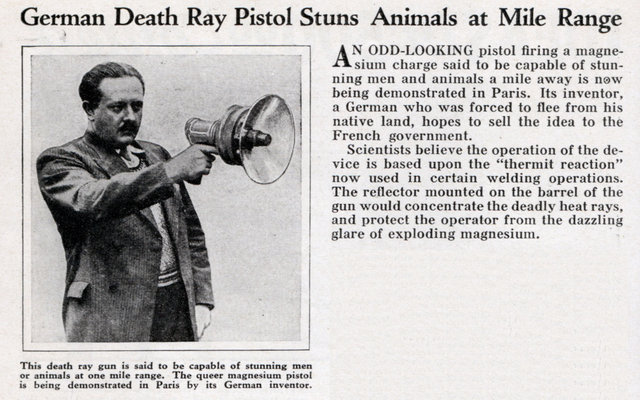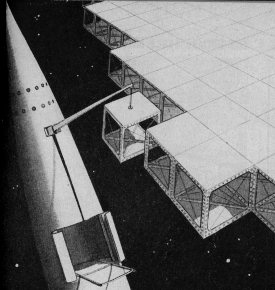(In order of words)
The… Donkeyfaust anti-partisan weapon system!
Was used operationally in Italy!
Multi-head Geballte Ladung with one M-24 stick grenade surrounded by 6 more heads!
22mm Luftfaust
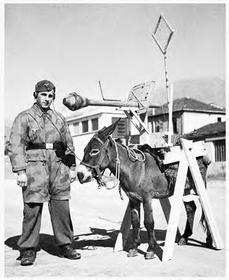



(In order of words)
The… Donkeyfaust anti-partisan weapon system!
Was used operationally in Italy!
Multi-head Geballte Ladung with one M-24 stick grenade surrounded by 6 more heads!
22mm Luftfaust



I am continually astounded at how many people take that ‘donkey faust’ photo as a serious weapon and not a practical joke done by bored soldiers with too much time on their hands.
As for the hand grenade, nothing unusual at all. Quite normal for the Germans. The stick grenade had quite a few neat features:
Handle making it easier to throw further
Removeable head that could be bundled together (as per picture) for an improvised anti-tank grenade.
Fragmentation sleeves (marginally effective)
Cord arming system that allowed the grenade to be tied to objects for bobby traps. One example I read of is hanging them from barbed wire so that when rattled the grenade drops.
I know its just a joke!
It’s rather the “Fliegerfaust”, the "Luftfaust had only four barrels IIRC.
Not really a small arm or infantry weapon but another strange-looking example of german weapon engineering: the “Stielgranate 41”, an attempt to improve the poor effect of the 3,7-cm Pak 35/36. An unconvenient side-effect of this grenade was that one poor soldier had to leave cover and step in front of the barrel to load.
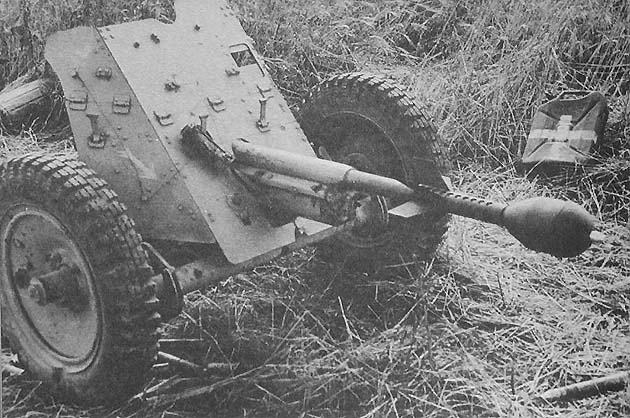
I saw the pictures in post #1. Just what does a fliegerfaust or luftfaust do? Since they have multiple barrels.
Well, the Fliegerfaust A was supposed to shot twelve 20mm-rockets in one salvo on low flying planes. I was mistaking about the Luftfaust (Fliegerfaust B) though, it seemed to have nine barrels, firing in two salvos.
Thanks flame. It would be interesting to know how it recoiled. I do like the donkeyfaust. Must have been one of Germanys last wonder weapons…it really makes you wonder.
Yes, it was special. When first encountered by allied troops, the “Eselfaust” was literally translated as “Assfist” but for comprehensible reasons they kept the “donkey” and the german word “Faust”. :lol:
It’s not much safer than a donkey mount.
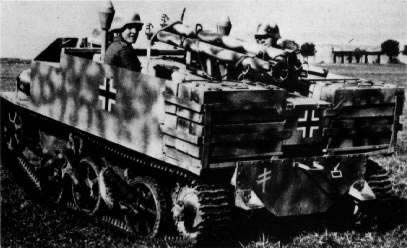
Ha-ha-ha!!! So do you think that the fliegerfaust would have more of a recoil than say a panzerfaust or panzerschreck? Since it would be firing several small projectiles?
The Germans…They have a weapon for everything;)
Well, at least the Fliegerfaust B or Luftfaust was as recoilless as the Panzerfaust and Panzerschreck.
There is one truly recoiless and literally throw and forget - the anti -tank grenade (Panzerwurfmine).
Allright, allright. To be the exact, those were weapons with the “principle of the recoilless gun” meaning no or very little recoil.
Looks like a candle or firestarter, but i guess it could still cook someone.
Cool, i’m up to sergeant…where are my stripes?
Looks rather like some tool of a vermin exterminator.
Some German Death Rays.
The Third Reich’s Diabolical Orbiting Superweapon
Written by Comrade Commisar on February 9th, 2008 at 4:19 am
Throughout the Second World War, the town of Hillersleben, Germany was home to one of the Third Reich’s most crucial weapons research centers. At a sprawling facility nestled in the forested hills, a contingent of 150 engineers and physicists developed and evaluated all manner of experimental weapons, a substantial number of which were ultimately adopted by the Nazi war machine.
When Germany surrendered in May 1945, the scientists at Hillersleben were forced to abandon an assortment of death-bringing innovations at various stages of completion. Among these were a rocket-assisted artillery shell which had 50% more range than standard artillery, a 600mm mortar which fired one-ton self-propelled projectiles for up to three and a half miles, a modified Tiger tank which could fire 760-pound rockets up to six miles, and a chain-like projectile made up of small, linked rockets with a range of 100 miles. But the military masterminds’ most sinister ambitions were embodied in their behemoth Sonnengewehr, or “Sun Gun” project– an orbital weapon intended to exact fiery punishment upon the enemies of the Third Reich, forever establishing their dominance over the genetically inferior Untermenschen of the Earth.
The Sun Gun was based on a design originally conceived by Hermann Oberth, a physicist who is widely credited as one of the founding fathers of rocketry and astronautics. In his 1929 book Wege zur Raumschiffahrt, or “Ways to Spaceflight,” Oberth presented a scientific description of a hypothetical manned space station orbiting at an altitude of one thousand kilometers. He detailed potential construction methods using prefabricated sections, described a rotational cycle to produce centrifugal gravity within the station, and outlined a system for periodic resupply missions. Oberth advocated the development of these Raumstations to serve as astronomical observatories and telegraph relays, in addition to Earth-observing activities such as meteorology, search-and-rescue, and military intelligence. What interested the Nazi scientists, however, was his suggestion that a specially engineered 100-meter-wide concave mirror could be used to reflect sunlight into a concentrated point on the Earth. But whereas Oberth’s design had peaceful intentions– to use the intense heat to produce electricity with steam turbines– the nefarious Nazis envisioned a colossal heat ray which could vanquish humanity.
Archimedes and one of his death ray mirrorsThe Sun Gun concept was essentially a scaled-up version of Archimedes’ ancient and oft-debated “Death Ray.” In 212 BCE, the Roman Republic sought to seize the city of Syracuse from its Greek inhabitants. Some accounts claim that the initial attack was repelled by Archimedes– the astonishingly talented Greek mathematician, physicist, inventor, and astronomer– who is said to have used an array of sunlight-concentrating copper mirrors to set the advancing ships aflame. Many scientific attempts have been made to confirm or deny the feasibility of such a weapon, with varying outcomes. Most prominently, the myth was “busted” on the television program MythBusters in 2006. The 'Busters found that an array of metal mirrors could indeed ignite a wooden ship, but only after a tactically-tricky exposure of several minutes. Although the authenticity of the ancient legend is questionable, however, the principle behind it is fundamentally sound.
Using Hermann Oberth’s 1929 design as a starting point, the optimistic physicists of Hillersleben expanded upon the space-mirror concept considerably. Their calculations indicated a parabolic mirror of at least three square kilometers to achieve the desired destructive power– about 100,000 times larger than Archimedes’ mythical death ray– and an ideal orbit of 8,200 kilometers. After considering a number of shiny materials, the scientists settled upon metallic sodium, an element which is relatively abundant among natural compounds. Under ordinary conditions, pure sodium tarnishes quickly and reacts violently to moisture, however the researchers reasoned that these shortcomings would not pose any problem in the virtually vacuous exosphere. To heft the pre-built pieces into orbit, engineers planned to employ a beefed-up version of trailblazing-but-treacherous V-2 rocket which Germany had been using to terrorize London. This “A11” multi-stage variant– which was undergoing development at the V-2 facility in Peenemünde– was designed by Wernher von Braun to deliver people into space, and to export white-hot Nazi shrapnel to the US.
Inside the living area of the station, electricity would be provided by special steam-driven dynamos which would utilize the heat of raw solar radiation. The station’s complement of Nazi astronauts would wear magnetic shoes to accommodate working in weightlessness, and their oxygen would be constantly replenished by vast onboard greenhouses filled with CO2-thirsty pumpkin plants. Artist’s impression of the assembly process (Life magazine, 1945)The crew of a fully-assembled Sun Gun station would receive encoded orders via radio or wireless telegraph, while keeping a sharp eye on enemies of the Reich. When commanded to attack a terrestrial target, the crew would engage a network of rocket thrusters to rotate the massive reflector into a carefully calculated orientation. Once in position, the mirror’s curvature would converge the sun’s mighty rays into a focal point on the Earth’s surface, pouring a column of raw, super-concentrated solar radiation upon the target site. Hypothetically this beam would have sufficient heat to scorch away fields, incinerate cities, vaporize reservoirs, and melt screaming onlookers like wax dummies. Any nation lacking space-capable rockets would be utterly defenseless against the onslaught. Once the desired destruction threshold was reached, the mirror would be tilted back into a safe orientation, facing away from the Earth.
The project was stalled in the summer spring of ‘45, however, as the impending Allied victory became increasingly evident. American intelligence agencies immediately invoked Operations Overcast and Paperclip to extricate German scientists and equipment ahead of the Soviets. Lieut. Col. John A. Keck, chief of the Ordinance Service’s enemy technical intelligence branch in European theater, led the interrogation of a number of Nazi researchers. The German engineers described their participation in the development of the V-2, and disclosed details regarding several other nearly-perfected technologies: a submarine-based V-2 launch system, an infrared sniper scope, and an anti-aircraft rocket capable of auto-detonating within ten yards of a target. In addition, they handed over the schematics and calculations for their formidable Sun Gun concept. Considering the Nazi scientists’ other impressive achievements, Lieut. Col. Keck and his team of hard-headed engineers took the death star concept seriously. “We were impressed with their practical engineering minds,” Keck said of the Hillersleben researchers, “and their distaste for the fantastic.”
Many American scientists, however, were more skeptical Sun Gun’s feasibility. Astronomical amounts of time, money, and resources would be required to hoist the hundreds of tons of equipment into orbit, not to mention the million or so tons of metallic sodium. Furthermore, there were doubts regarding whether a single parabolic mirror could concentrate destructive levels of energy upon such a distant focal point; though this problem could be overcome by building multiple Sun Guns to operate as an orchestrated orgy of annihilation. In spite of the monumental scale of the concept, the physicists from Hillersleben were confident that their Sonnengewehr Raumstation was feasible, and that its uninterrupted development could have furnished the Fatherland with global conquest in as little as fifty years.
Solar furnace in Odeillo, FranceThe weaponization of the sun has still yet to be realized, though similar concepts are used today to collect heat on smaller scales. Solar furnaces use parabolic mirrors provide heat for cooking, electricity, metal-working, and hydrogen production. The largest solar furnace in the world is currently located in the commune of Odeillo in the French Pyrenees mountains, where its eight-story-tall array of 10,000 small mirrors concentrates sunlight to produce temperatures up to 3,000 degrees Celsius. A similar concept is used in solar power towers, where a brigade of mirrors reflect the sun’s heat onto a central receiver to produce steam for electricity.
Despite appearances, the Hillersleben researchers were not exclusively sinister. Nestled amongst the heat-ray-of-doom diagrams, scientists included notes describing the space station’s potential as a radio-relay satellite, a weather observation post, a launch pad for the interstellar rocket expeditions, and of course, Hermann Oberth’s original vision to use the giant mirror to generate electricity on Earth.
Many German rocket scientists– including Oberth and Wernher von Braun– ultimately opted to put science ahead of patriotism, and moved to the US to continue their rocketry research. In addition to their work with US missile defense systems, many of the men went to work for the fledgling space program in the 1950s. The rocket originally slated to carry the Sun Gun segments into space– Von Braun’s A11– eventually became the foundation for the Saturn V, the engine which carried the Apollo astronauts into orbit for the moon missions of 1969-1972. It seems that through hard work and perseverance, these pioneers of rocketry finally managed to hit their ultimate goal: The stars. And occasionally, London.
